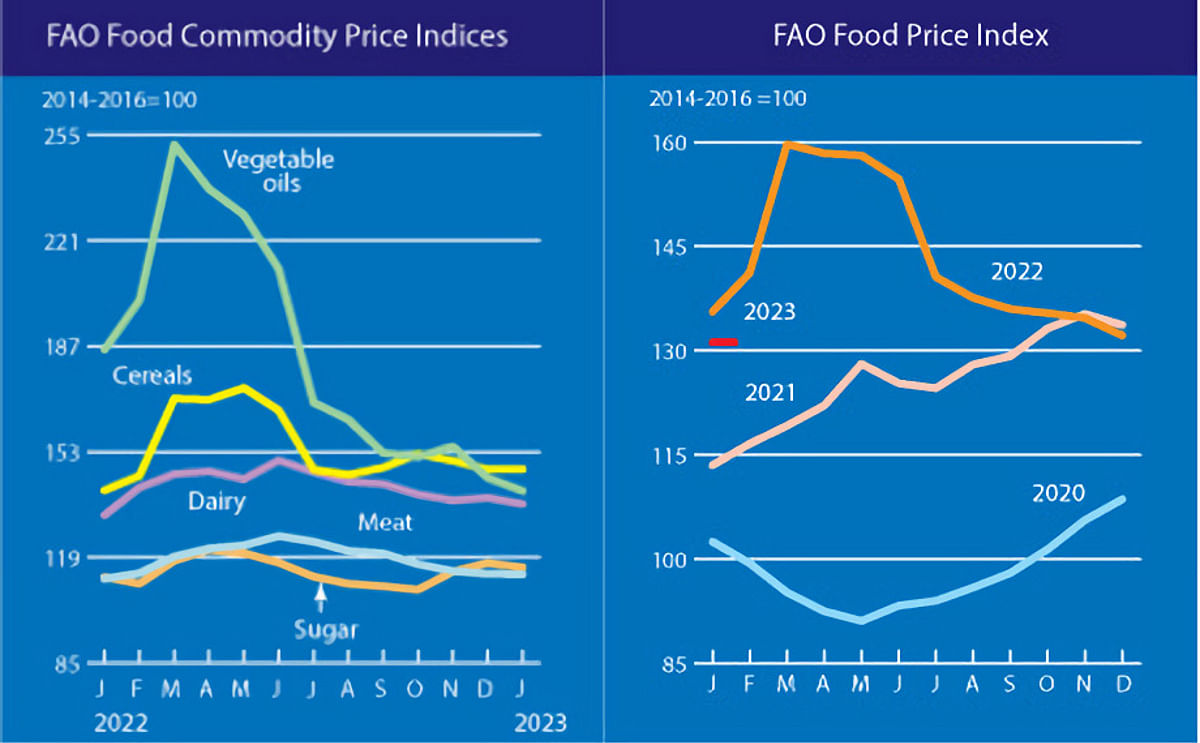FAO Food Price Index continues to decline
FAO Food Price Index continues to decline in January 2023

The FAO Food Price Index* (FFPI) averaged 131.2 points in January 2023, down 1.1 points (0.8 percent) from December, marking the 10th consecutive monthly decline.
With this latest decline, the index has fallen 28.6 points (17.9 percent) from the peak it reached in March 2022. The drop in the index in January was driven by declines in the price indices of vegetable oils, dairy and sugar, while those of cereals and meat remained largely stable.
The FAO Cereal Price Index averaged 147.4 points in January, up fractionally (0.1 percent) from December and 6.7 points (4.8 percent) above its level one year ago. Among the major cereals, world prices of rice and maize rose, while those of barley and wheat fell in January.
International rice prices increased by 6.2 percent month-on-month, influenced by tighter availabilities, a strong local demand in some Asian exporting countries and exchange rate movements.
World maize prices also increased, albeit marginally (0.5 percent), mostly influenced by a strong demand for exports from Brazil and concerns over dry conditions in Argentina, offsetting a downward trend in US export prices amidst slow sales.
Among other coarse grains, world prices of sorghum increased slightly (0.9 percent), mainly influenced by the strength in maize markets and lower production in the United States of America, the top global exporter, while the decline in barley prices (1.0 percent) reflected spillover from the global wheat market.
Meanwhile, international wheat prices fell for a third consecutive month in January, by 2.5 percent, as global supplies increased with larger than previously estimated production in Australia and the Russian Federation.
The FAO Vegetable Oil Price Index averaged 140.4 points in January, down 4.2 points (2.9 percent) month-on-month and standing nearly 25 percent below its level a year ago. The decrease reflected lower world prices of palm, soy, sunflowerseed and rapeseed oils.
In January, international palm oil prices dropped for the second consecutive month, largely weighed by subdued global import demand, as major importers replenished their stocks during the past few months.
World soyoil quotations also fell moderately, linked to sluggish import demand due to uncompetitive prices compared with those of other vegetable oils, as well as improved weather conditions in Argentina lately, raising production prospects. In the case of sunflower and rapeseed oils, international prices fell on ample global export supplies.
The FAO Dairy Price Index averaged 136.2 points in January, down 2.0 points (1.4 percent) from December, hitting its lowest level in 12 months. The decline in January reflected lower international prices of butter and milk powders.
World butter prices fell for the seventh consecutive month, underpinned by subdued import demand for long-term supplies at prevailing prices, stemming from market expectations for prices to fall further and increased supplies from Oceania.
Meanwhile, international whole milk powder prices declined on lighter demand from leading importers and increased supplies from New Zealand, despite seasonally declining milk output. Skim milk powder prices also fell, mainly due to a sluggish global demand.
By contrast, world cheese prices increased slightly, driven by a recovery in food services and retail sales in Western Europe, following the new-year holidays, and currency movements.
The FAO Meat Price Index* averaged 113.6 points in January, down marginally (0.1 points and 0.1 percent) from December, continuing the decline for the seventh consecutive month, but it still stood 1.5 points (1.3 percent) above its year-earlier level.
Lower world prices of poultry, bovine and pig meats underpinned the decline in the index in January. World poultry meat prices fell further as global export availabilities from leading suppliers continued to exceed import demand, despite widespread avian influenza outbreaks.
Meanwhile, pig meat prices fell slightly due to ample supplies of slaughter-ready pigs, especially in Brazil and the United States of America, and lower-than-expected imports by China ahead of the Spring Festival.
Likewise, international bovine meat prices declined, with increased supplies of slaughter-ready cattle, mainly in Oceania. By contrast, ovine meat prices rose on higher import demand, notwithstanding increased slaughter volumes in Australia.
With this latest decline, the index has fallen 28.6 points (17.9 percent) from the peak it reached in March 2022. The drop in the index in January was driven by declines in the price indices of vegetable oils, dairy and sugar, while those of cereals and meat remained largely stable.
The FAO Cereal Price Index averaged 147.4 points in January, up fractionally (0.1 percent) from December and 6.7 points (4.8 percent) above its level one year ago. Among the major cereals, world prices of rice and maize rose, while those of barley and wheat fell in January.
International rice prices increased by 6.2 percent month-on-month, influenced by tighter availabilities, a strong local demand in some Asian exporting countries and exchange rate movements.
World maize prices also increased, albeit marginally (0.5 percent), mostly influenced by a strong demand for exports from Brazil and concerns over dry conditions in Argentina, offsetting a downward trend in US export prices amidst slow sales.
Among other coarse grains, world prices of sorghum increased slightly (0.9 percent), mainly influenced by the strength in maize markets and lower production in the United States of America, the top global exporter, while the decline in barley prices (1.0 percent) reflected spillover from the global wheat market.
Meanwhile, international wheat prices fell for a third consecutive month in January, by 2.5 percent, as global supplies increased with larger than previously estimated production in Australia and the Russian Federation.
The FAO Vegetable Oil Price Index averaged 140.4 points in January, down 4.2 points (2.9 percent) month-on-month and standing nearly 25 percent below its level a year ago. The decrease reflected lower world prices of palm, soy, sunflowerseed and rapeseed oils.
In January, international palm oil prices dropped for the second consecutive month, largely weighed by subdued global import demand, as major importers replenished their stocks during the past few months.
World soyoil quotations also fell moderately, linked to sluggish import demand due to uncompetitive prices compared with those of other vegetable oils, as well as improved weather conditions in Argentina lately, raising production prospects. In the case of sunflower and rapeseed oils, international prices fell on ample global export supplies.
The FAO Dairy Price Index averaged 136.2 points in January, down 2.0 points (1.4 percent) from December, hitting its lowest level in 12 months. The decline in January reflected lower international prices of butter and milk powders.
World butter prices fell for the seventh consecutive month, underpinned by subdued import demand for long-term supplies at prevailing prices, stemming from market expectations for prices to fall further and increased supplies from Oceania.
Meanwhile, international whole milk powder prices declined on lighter demand from leading importers and increased supplies from New Zealand, despite seasonally declining milk output. Skim milk powder prices also fell, mainly due to a sluggish global demand.
By contrast, world cheese prices increased slightly, driven by a recovery in food services and retail sales in Western Europe, following the new-year holidays, and currency movements.
The FAO Meat Price Index* averaged 113.6 points in January, down marginally (0.1 points and 0.1 percent) from December, continuing the decline for the seventh consecutive month, but it still stood 1.5 points (1.3 percent) above its year-earlier level.
Lower world prices of poultry, bovine and pig meats underpinned the decline in the index in January. World poultry meat prices fell further as global export availabilities from leading suppliers continued to exceed import demand, despite widespread avian influenza outbreaks.
Meanwhile, pig meat prices fell slightly due to ample supplies of slaughter-ready pigs, especially in Brazil and the United States of America, and lower-than-expected imports by China ahead of the Spring Festival.
Likewise, international bovine meat prices declined, with increased supplies of slaughter-ready cattle, mainly in Oceania. By contrast, ovine meat prices rose on higher import demand, notwithstanding increased slaughter volumes in Australia.
*Unlike for other commodity groups, most prices utilized in the calculation of the FAO Meat Price Index are not available when the FAO Food Price Index is computed and published; therefore, the value of the Meat Price Index for the most recent months is derived from a mixture of projected and observed prices. This can, at times, require significant revisions in the final value of the FAO Meat Price Index which could in turn influence the value of the FAO Food Price Index.
Like to receive news like this by email? Join and Subscribe!
Get the latest potato industry news straight to your WhatsApp. Join the PotatoPro WhatsApp Community!
Highlighted Company
Sponsored Content
Sponsored Content
Sponsored Content
Sponsored Content










